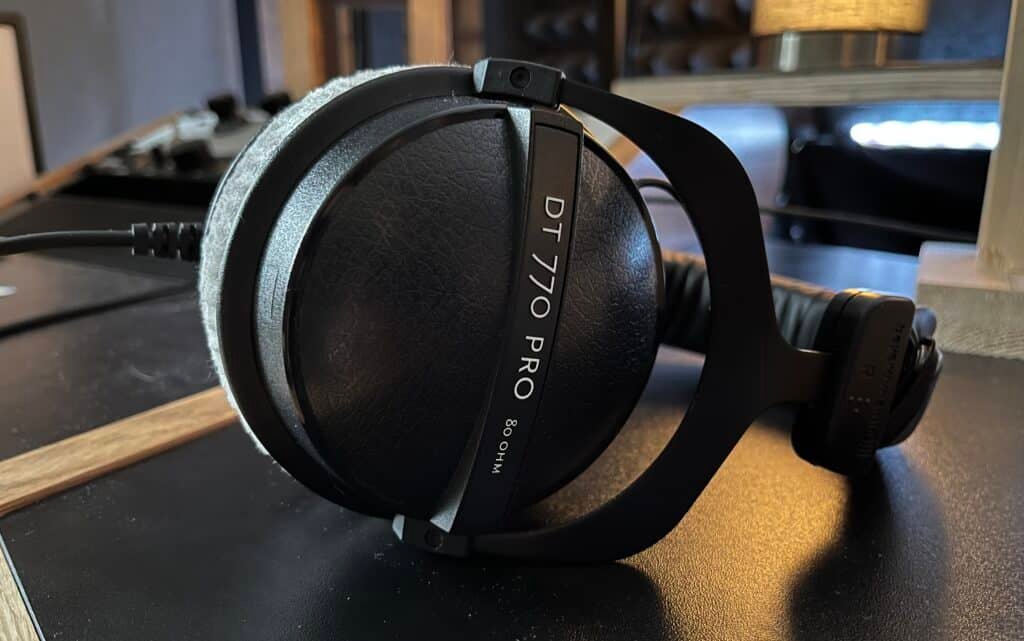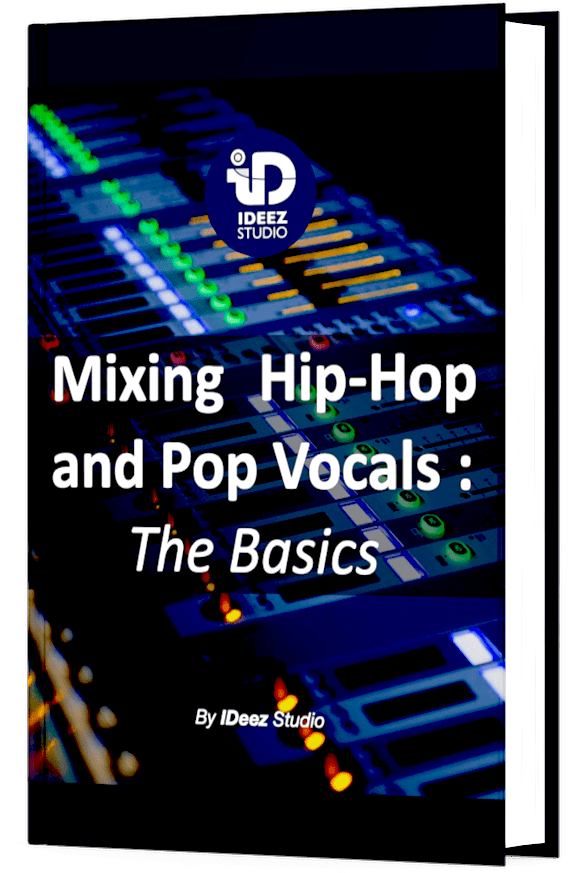If you’re starting to get interested in music production, you might have noticed that there are two main types of headphones: pro headphones and consumer headphones. But what’s the difference between these two types of headphones? In this article, you’ll see that the difference goes far beyond sound.

From the outside, the difference may seem small or even non-existent. But in reality, many parameters differentiate the two types of headphones.
Does pro mean that these headphones are simply better than the “poor quality” consumers? It’s actually more complex than that, because it depends on what you’re looking for when buying headphones.
Consumer headphones prioritize enjoyable sound with boosted bass and treble, comfort, and portability for everyday listening, while professional headphones focus on accuracy, durability, and neutral sound reproduction for critical studio use by audio professionals.
1. Durability and build quality
If you thought that the materials used were always the same whatever the headphones, well let me tell you, they’re not. And the materials used in pro headphones are generally of much higher quality.
Consumer headphones, for example, use a lot of poor-quality plastic to prioritize other aspects such as style. Using “poor” materials also helps to keep the manufacturer’s costs down.

Pro audio headphones, on the other hand, are generally made from more solid, robust materials, such as metal. And while there will always be an element of plastic even in pro audio headphones, their build process is much more meticulous to ensure that the user can wear them for long periods of time.
In other words, build quality is rarely the priority of consumer headphone manufacturers, who prefer to prioritize design. Whereas pro headphone manufacturers prefer to prioritize build quality over style.
ℹ️ If you’re considering buying studio headphones, then I recommend you read this article on the 8 Things To Consider Before Buying Studio Headphones
2. Portability
Consumer headphones are generally designed for easy portability. For example, many consumer headphones have foldable ear cups and a bag that allows the headphones to be carried on the move, for running, sports, etc. In short, to move around without worrying about damaging the headphones.

Studio headphones, on the other hand, are rarely portable. It’s much more complicated to fold them up or put them in a bag for transport. Which makes sense, since they’re designed to be used exclusively in the studio environment.
However, there are a growing number of “hybrid” headphones in terms of portability. I’m thinking in particular of certain models of Audio Technica headphones, which can be folded in on themselves, and whose mini-jack can be easily removed from the headphones.

3. Connectivity
Connectivity is also an important parameter in differentiating consumer headphones from pro audio headphones. Especially today, when consumer headphones are becoming more and more an everyday tool than a simple music player. Let me explain!
With a view to easy portability and optimum comfort (as mentioned above), most consumer headphones operate via Bluetooth (with optional cable connection). Many of today’s models also feature touch controls, and built-in microphones for hands-free calling.

All these parameters make consumer headphones more convenient to use, but much less reliable and stable in terms of sound rendering.
In the case of pro headphones, the use of a jack connector is essential for the manufacturer. Because the physical transmission of the audio signal is much more reliable and stable than transmission via Bluetooth.
As the audio rendering of pro headphones is a top priority for manufacturers, it goes without saying that the use of a jack is essential for these types of headphones. The system may be less “convenient” for the user, but transmission quality is assured!
4. Sound quality
As you’d expect, sound quality is one of the main parameters that differentiates pro headphones from consumer headphones. But what exactly is it about the sound that differentiates the two? Why do pro headphones sound so much “better”?
In fact, what you need to understand is that the objective of each type of headphone is completely different. For one (consumer headphones), the aim is to give the consumer pure listening pleasure. For the other, the aim is to render sound as reliably as possible to the sound engineer, producer or musician.

Consumer headphones will therefore often have a sound that amplifies the bass and/or boosts the treble range to make each piece of music more exciting, bigger, more immersive. And this is often to the detriment of sonic reliability.
With pro headphones, excitement and fatness are far from the manufacturers’ priorities. Their aim is to render sound as reliably as possible, so the frequency spectrum is as flat as possible in the ears.
Of course, this remains theoretical, and completely flat audio simply doesn’t exist. But if you switch from consumer headphones to pro headphones over a short period of time, you’ll be impressed by the difference in sound quality.
Looking for a professional sound engineer specializing in pop and hip-hop music ? You’re in the right place! Mixing, mastering, production, editing,… we’ve got it all covered!
Let’s start now!
5. Isolation and noise cancellation
For modern consumer headphone manufacturers, isolation is a parameter that has become very important over the last few years. Brands have come to understand that what people like about listening to music through headphones is being isolated, in one’s own bubble.
That’s why, for some years now, consumer headphones have generally been equipped with intelligent, highly precise and adjustable isolation and noise cancellation systems, enabling users to manage the level of isolation of their headphones.
Nowadays, few consumer headphones (of minimum quality) don’t have good isolation. This has become a priority parameter for manufacturers.

Pro headphones, on the other hand, generally have no such isolation or noise-cancellation systems. There are two reasons for this.
Firstly, it’s simply not necessary. The studio environment is often very quiet, requiring no additional isolation to listen to music through headphones in complete tranquillity.

And secondly, headphones used in the studio are rarely linked directly to a computer or phone. The signal usually passes through a headphone amp and/or converters of some kind. This kind of technology would be more a source of slowdown than anything else.
Although some pro headphones have good isolation, this is not usually the manufacturer’s priority. And you’ll probably never see pro headphones with noise cancelling systems. Unless the future holds some unexpected surprises!
ℹ️ The isolation of studio headphones can be very different depending on whether they are closed-back or open-back. I’ll explain this essential difference right here: Closed-Back vs Open-Back Headphones: What Is The Difference?
6. Use Cases
As you may have noticed when reading this article, the use cases for pro headphones and consumers are very different.
Pro headphones are not designed to be used in everyday life, for listening to music in the street, watching movies or gaming. They are designed to be used by music professionals (or anyone wanting to become one).
Consumer headphones, on the other hand, are not designed for use in music production and the studio. They’re made for people who simply want to enjoy listening to music, whether they’re in or out of the music production business.
Of course, there’s nothing to stop you “breaking” the rules. And that you use, for example, pro headphones for your everyday life. But chances are you’ll soon notice that each type of headphone is designed for a specific use and not for anything else.

Popular pro headphones
Beyerdynamic DT-770

These days, when you walk into a professional recording studio, the chances are 9 out of 10 that you’ll find these headphones: the Beyerdynamic DT-770. It’s been the most popular choice among music production enthusiasts and professionals for many years.
These headphones have the advantage of having a fairly flat and reliable frequency response, of being particularly comfortable and also… of having unbeatable value for money.
If you want to get started in music production, the Beyerdynamic DT-770 is a very good choice that will enable you to enjoy professional, reliable sound for all your future productions.
Audio Technica ATH-M50x

The Audio-Technica ATH-M50x headphones are also a very popular choice among music producers, sound engineers, and audiophiles alike. These headphones deliver accurate and detailed sound across the frequency spectrum.
Built with professional use in mind, the ATH-M50x headphones boast a robust construction that can withstand the rigors of daily studio use. The collapsible design also allows for easy storage and transportation. With their cushioned ear pads and headband, comfort is also a big strength of the ATH-M50x headphones .
Versatility is another hallmark of the ATH-M50x headphones, thanks to their detachable cable design. Overall, the Audio-Technica ATH-M50x headphones offer a winning combination of superb sound quality, durability, comfort, and versatility, making them a top choice for professionals and music lovers alike, who want to enjoy quality sound in their daily headphone use.
Popular Consumer headphones
Sony WH-1000XM4

For several years, the Sony WH-1000XM4 headphones are super popular thanks to their industry-leading noise cancellation technology and exceptional sound quality. Equipped with Sony’s proprietary HD Noise Canceling Processor QN1, these headphones can effectively block out ambient noise.
The sound signature is balanced and dynamic, with deep bass, clear mids, and crisp highs. The WH-1000XM4 also features Adaptive Sound Control, which adjusts the noise-canceling settings based on your activity and environment. They offer convenient touch controls, multipoint Bluetooth connectivity, and smart features like proximity sensors and voice assistant support, making them one of the top choices for consumers seeking premium wireless headphones.
Bose QuietComfort 35 II

The Bose QuietComfort 35 II headphones have exceptional noise-canceling capabilities as well (as its name indicates), thanks to Bose’s renowned Acoustic Noise Cancelling technology.
The sound of the Bose QuietComfort 35 II headphones has rich bass, clear vocals, and detailed highs, delivering an immersive listening experience across a wide range of genres. The QuietComfort 35 II headphones also offer convenient features like built-in Google Assistant and Amazon Alexa support.
Conclusion
The difference between consumer and pro headphones goes far beyond sound quality. Parameters such as durability, build quality, portability, connectivity and isolation also influence this difference.
But as you can see, one isn’t inherently “better” than the other. They are simply built and designed differently to be used in different contexts. Of course, sound quality, which is an important parameter, is better with pro headphones, but other parameters are also important when choosing headphones. So your choice will always depend on your needs!
If you have any questions about this topic or about anything in the field of music production, please contact me and I’ll be very happy to help you!
Related Articles:
My favorite tools for mixing pop and hip-hop music:
Plugins
In the field of auto-tune, I’m convinced that nothing’s better and more efficient than Antares Auto-Tune Pro. As for the EQ’s, FabFilter Pro-Q3 and Slate Digital Infinity EQ are, in my opinion, the best tools. For compression, I have 2 favorites plugins: Waves RComp and UAD EL8 Distressor.
As for reverb, I’m a big fan of the Soundtoys Little Plate, but generally, I go for the Valhalla VintageVerb for its versatility. I also love the Arturia Rev PLATE-140 and the UAD Pure Plate for its organic side.
Headphones
The closed headphones I love and will always love using for mixing pop and hip-hop music are the Beyerdynamic DT-770. As for the best open-back headphones, I use the Sennheiser HD600 headphones, and I’m really happy of them!
Monitors
Having a pair of Yamaha HS7 in its studio or home studio is always cool for more excitement while listening to your mixes. The Adam Audio T7V monitors are also super accurate. In my studio, I also have a pair of Genelec 8030 for their reliability.
Hardware gear
For anyone who wants to start using hardware in their mixes, I always recommend these 2 units from Klark Teknik: the EQP-KT and the 76-KT. Don’t forget to use good converters, such as the Apollo interfaces. This is essential for a good rendering.






